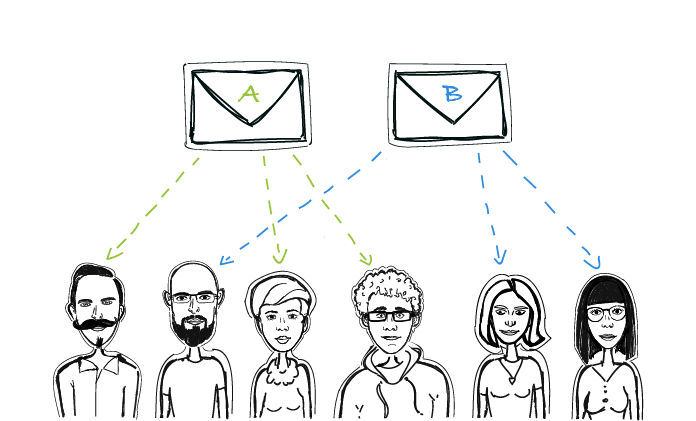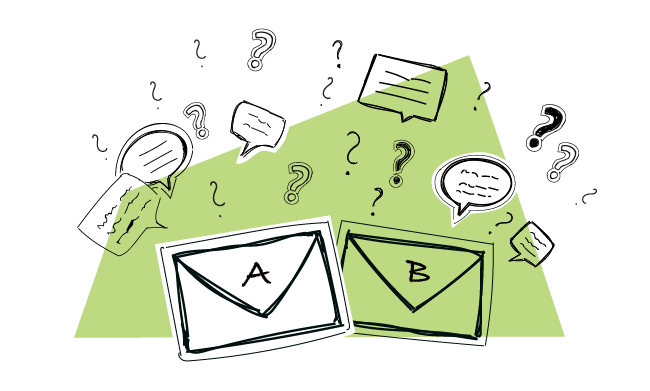Cold outreach needs a lot of experimentation before you get it right. You can tinker with cold email copy, subject line, CTA, and other elements to optimize your cold email. However, how do you know what to focus on?
Thankfully, you’ve got a stats board and you’re able to clearly see what’s not working. Below, I’ll focus on three crucial cold email rates and what to do to give them a boost. And that boost usually comes from A/B testing one element.
If you want to learn what specific cold email rates mean, read this: What Outbound Sales Metrics Should We Track and Why? >>
Keep in mind that we need to A/B test on a homogenous group. Here’s more about what is a homogenous group is and how to carry out A/B testing >>
Do you prefer learning from videos? Check this one, then:
What to A/B test if you want to improve the open rate?
Open rate tells you how many of the delivered emails in a campaign were opened. Open rate doesn’t determine your campaign’s success. Yet, the more prospects open your email, the greater the chance they reply positively to it.
There’s a lot of aspects you may test to improve the open rate. But before I discuss any of them, I need to draw your attention to a few things.
The way you send your emails impacts the number of the email opens you get. If you send cold emails with an email marketing tool, you may get yourself into the “Promotions” tab. That’s because this tool uses their own SMTP.
More on that here: What’s the difference between cold email and marketing emails? >>
That’s it for landing in the “Promotions” tab. There’s another place your email can unfavorably fall into — the SPAM folder. If you don’t get your SPF and DKIM properly set up, there’s a high chance your email gets to SPAM and won’t ever get opened or read. Or your email server’s IP gets blocked from sending. Similarly, you may have used some vocabulary that triggers SPAM filters. Check the list here: 100 Common Email SPAM Words to Avoid >>
When your open rate falls short of your expectations, check whether your emails get into the primary tab. If they do, here is a set of things you can A/B test to improve the open rate.
Subject line
The subject line is like a key that opens your message. It compels the receiver to click on the message. For that reason, it affects the open rate of the whole campaign.
Your subject line should be intriguing enough for prospects to open the email. The most intriguing subject lines I can think of are the ones that are centered around the prospect. They include praise or highlight the benefit that the prospect can get from your cooperation.
But writing a good subject line isn’t easy. The subject that contains a joke may work well on one target group, while the other group may scorn at the same subject line. Or a question may get more attention than a statement. It all needs to be tested.
It can be that you won’t see any differences in the open rate when you split test the subject. In such a case, continue testing other elements.
Check out: 12 Irresistible Sales Email Subject Lines: Can You Spot The Pattern? >>
From line
The “From:” line appears right next to the subject line. It shows the recipients who the message comes from. So, it may make or stop them from opening the email.
If few people open your email, you can try to test the “From” line. Remember when Cathy shared five possible versions of the “From” line.
Here they are,
A. First name (Cathy)
B. First name + Last name (Cathy Patalas)
C. First name + Last name, Title (Cathy Patalas, Head of Marketing)
D. First name + Company name (Cathy at Woodpecker.co)
E. First name + Last name + Company name (Cathy Patalas at Woodpecker.co)
Pick two and test whether the open rate has improved or not.
Introduction
The introduction of cold email copy affects the open rate too because you don’t need to open the email to see most of it in the inbox. Remember that intro shouldn’t introduce you. That’s the job of the “from” line and the signature.
The intro, however, catches the recipient attention by mentioning something about them and why you email them and not any other person. If you start talking about yourself in the very first sentence, your recipients may not want to talk with you.
Delivery time
The time when your email enters the inbox matters. Send it at the wrong time and your reply rate suffers. As Cathy wrote before, the best delivery time is not universal. You need to experiment to find what works best on your target group.
Maybe you change your time from early to late hours and your open rate increases? It’s all open to testing.
Keep in mind your email provider’s sending limits when planning a cold email campaign.
What to A/B test if you want to improve the reply rate?
Reply rate tells you how many of the people who opened the message, replied to it. You want it as high as possible. The first thing that influences the reply rate is your target group. You need to reach people who can benefit from your offering. The other factor is the copy of your email. What elements of the copy can we A/B test to get our reply rate into shape?
Introduction
Not only does the message intro influence the open rate, it has something to do with the reply rate too. A bad intro may discourage the addressee from reading the message let alone responding to it.
That’s why it’s important to explain why you’ve chosen to contact the person. And telling them that you have an amazing company is not enough. Try two different intros without changing any other copy element and compare results.
Value proposition
Another thing that affects the reply rate is the way you pitch to your prospect. A key to comparing value proposition may be talking about different benefits in version A and different ones in B. Then, checking which one seems to be more beneficial to your target.
Signature
The content of your signature matters. It shouldn’t be too long nor too vague. Here are the elements you can experiment with when it comes to the signature:
- Name and surname
- Job title
- Email address
- Physical address
- Link to company website
- Link to a blog or other materials
- Social profiles
- Phone number
- Photo
- Sign off
Call to Action
CTA is a major thing that elicits replies. It tells your addressee what you want from them. Too complicated or too hazy and they won’t write back to you. If you’re not sure whether your ask is too big or unspecific, test it out.
What to A/B test if you want to improve the interest rate?
You’ve got a mountain of replies to your campaign, but how many of them are interested? There are a couple of things you can do to make your interest rate higher. But there are some things that influence the amount of interest you get that is hard to test:
- your target group; consider a lean approach to cold email to improve your target;
- what you publish about your company on the Internet; consider reviewing what your website and social media profiles tell about you.
However, other elements can be easily tested. Again, those elements are involved with email copy.
If you get replies, but the majority of them are negative, you may want to change the template you use. If you use one that you found online that is it. Change it. Learn how to effectively use templates here:
What to Write in an Opening Message to Ace Email Outreach >>
Sometimes the way you schedule your follow-up messages can get people annoyed. That’s why you should test how you should space them out. But I think that the easiest thing to A/B test is the call to action you use.
What to take away from it?
A lot of people give up cold emailing too easily. Sometimes a small adjustment leads to amazing results. That’s why you should always be testing to identify the best way of email outreach to your prospect group. Thankfully, you can monitor your campaign’s performance and adjust it. Just take a peek at your stats board and identify what’s wrong.
If you decide to give an A/B testing a go, here’s a full guide on doing that in Woodpecker.
How to do A/B test in Woodpecker >>
READ ALSO

A/B Testing in Cold Email: How to Optimize Our Copy to Get More Replies?
Split tests, or A/B tests, are a well-known method for website’s or newsletter’s copy optimization. But cold email copy also needs constant changes if it is to bring optimal effects. Here’s a little about split testing in cold email: which parts of our email can be tested, how can we test most effectively, what tools can we use for convenient comparison of results?

Outbound Sales Metrics Demystified – Which Should You Track & Why?
How do you know if your campaigns work or not? The answer is of course: metrics. What outbound sales metrics should you track? What affects delivery rate and what can you do to boost it? What can you change in your email content and settings to get more opens, more (positive) replies, and more customers? In this article, we investigate the most important sales metrics for outbound campaigns.

A/B Testing in Email: an FAQ to Clear All Your Doubts
About two months ago Vovik, our Head of Inbound Sales, hosted a live Q&A to share his knowledge of A/B testing in email. We were surprised at how many questions you guys asked! It looks like the topic of A/B tests in email needs to be explained in more detail, so I teamed up with Vovik to provide even more A’s to your Q’s. Check them out below.

